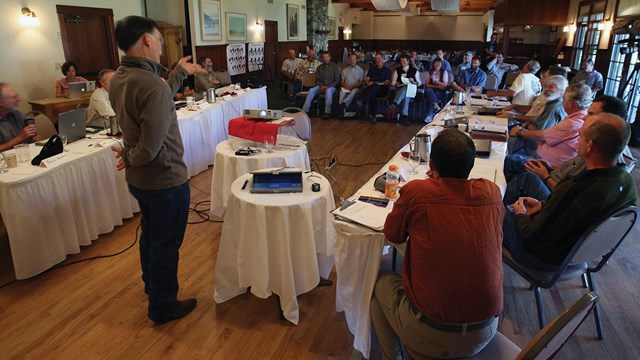
NPS/Janine Waller Yellowstone's extremophiles, especially thermophiles, have been the subject of scientific research and discovery for more than 100 years. The discovery of Thermus aquaticus bacteria in the 1960s has had scientific and economic benefits far beyond what anyone could have imagined and has played into the growing scientific interest in bioprospecting and extremophiles—calling greater attention to the research potential of Yellowstone. Today, several scientific research projects sponsored by universities, NASA, and corporations are underway in the park to investigate extremophiles. Some of their discoveries have helped researchers create inventions suitable for commercial purposes. When this happens, we call it bioprospecting. Bioprospecting does not require the sort of grand-scale resource consumption required by the kinds of extractive industries typically associated with the term "prospecting," such as logging and mining. In this case, the "prospecting" is for new knowledge. Research is encouraged in Yellowstone if it does not adversely impact park resources and visitor use and enjoyment. Importantly, only research results, i.e., information and know-how gained during research on park specimens, may be commercialized—not the specimens themselves. Park Science Informs Inventing Yellowstone's geology provides a wide variety of high- temperature physical and chemical habitats that support one of the planet's greatest concentrations of extremophilic biodiversity. Research on these extremophiles can discover new enzymes that can withstand harsh manufacturing processes better than inorganic catalysts, improving efficiency, which saves energy. In some cases, using enzymes instead of inorganic chemicals can also help reduce toxic industrial by-products. Research on these extremophiles has recently helped scientists invent a wide variety of potential commercial applications, from methods for improving biofuel production to helping agricultural crops withstand drought and high temperatures. Biggest Innovation from Yellowstone, So Far Until the 1980s, our ability to study DNA was limited. Things we take for granted today such as DNA fingerprinting to identify criminals, DNA medical diagnoses, DNA-based studies of nature, and genetic engineering did not exist. But in 1985, the polymerase chain reaction (PCR) was invented. PCR is an artificial way to do something that living things do every day—replicate DNA. PCR is the rocket ship of replication, because it allows scientists to make billions of copies of a piece of DNA in a few hours. Without PCR, scientists could not make enough copies of DNA quickly enough to perform their analyses. However, the heat necessary to do the PCR process inactivated the enzymes making the process extremely slow and expensive. They found the solution to this problem in one of the hot spring organisms isolated from Yellowstone by park researcher Thomas Brock in the 1960s; Thermus aquaticus. An enzyme discovered in T. aquaticus—called Taq polymerase—made PCR practical. Because it came from an extremophile, Taq polymerase can withstand the heat of the PCR process without breaking down like ordinary polymerase enzymes. In 1989 Taq polymerase was named Science magazine's first-ever "Molecule of the Year." Many laboratory-made versions of this enzyme are still in use allowing DNA studies to be practical, effective, and affordable. Companies that sell the Taq enzymes have earned profits, but Yellowstone National Park and the United States public receive no direct benefits even though this commercial product was developed from the study of a Yellowstone microbe. Benefits SharingFederal legislation authorizes the National Park Service to negotiate benefits-sharing agreements that provide parks a reasonable share of profits when park-based research yields something of commercial value. The National Park Service examined benefitssharing options and decided to require it for new inventions made through study of park resources. Source: NPS DataStore Saved Search 3627. To search for additional information, visit the NPS DataStore. 
Life in Extreme Heat
Hydrothermal features are habitats for microscopic organisms called thermophiles: "thermo" for heat, "phile" for lover. 
Beyond Boundaries
Managers from local, state, and federal agencies across the Greater Yellowstone Ecosystem coordinate efforts around resource issues. |
Last updated: April 18, 2025
